LED Display Guide: Top Tips and Insights
Table of Contents
If you’re curious about what an LED display is, look no further than the vibrant billboards that adorn Times Square – there lies your answer! These immense screens shine with a brilliance that can battle the glaring sun, all while standing resilient against powerful winds and rain. But is this high brightness and durability a standard feature across all LED displays?
Its intended usage heavily influences factors like brightness, resolution, and dimensions of an LED display. For instance, the billboards you see outdoors are crafted to exhibit superior brightness, a broad viewing spectrum, and enhanced IP ratings to brave the harsh elements. In contrast, their indoor counterparts are not necessitated to exhibit the same hardiness level. Moreover, the specific technology utilized in these displays markedly affects their efficacy. To make an informed purchase, acquaint yourself with key terminologies such as pixel pitch, contrast ratio, and refresh rate.
I’ve assembled a detailed guide on LED displays to facilitate your journey. This guide will delve into various display categories, pioneering technologies, and additional factors that will guide you to the optimal LED display selection. So, let’s embark on this informational voyage without further ado.
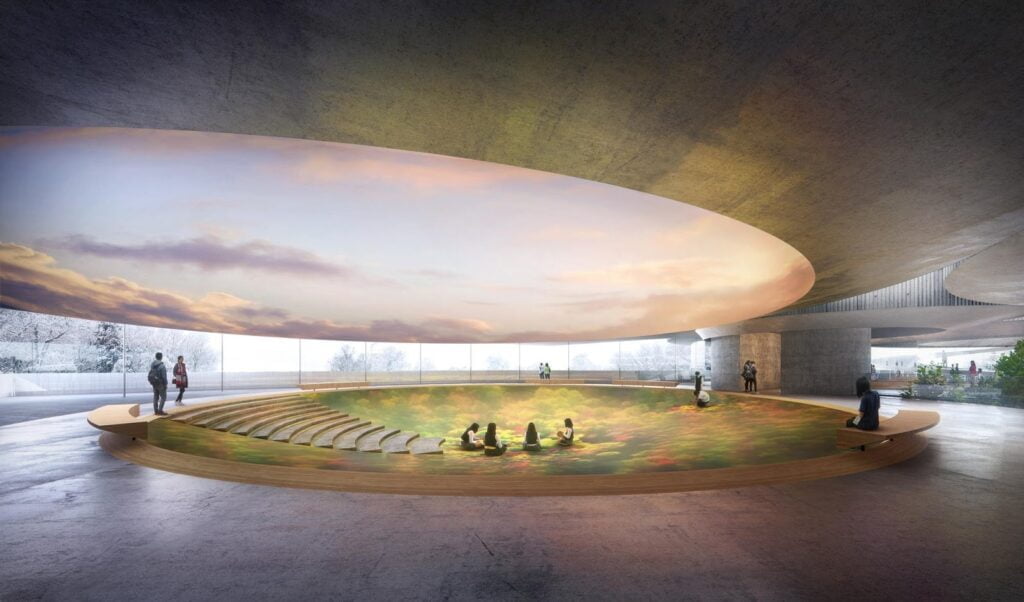
Understanding LED Displays
An LED display utilizes light-emitting diode panels as pixels to craft bright and dynamic text, imagery, videos, and other forms of visual content. It stands as a modern and more resourceful substitute for LCD technology.
In today’s market, LED displays are revered for their superior brightness, impressive contrast ratios, and energy-efficient attributes, making them the premier choice for marketing ventures. They seamlessly integrate into indoor and outdoor settings, gracing locations such as malls, banking institutions, stadiums, highways, retail outlets, transit hubs, and more. Technological progress has introduced innovative trends like OLED, Mini-LED, HDR LED, and transparent LED displays, adding to the versatility of this medium.
The Dynamics of LED Display Functioning:
The underlying technology dictates the functionality of LED displays. While some require the assistance of backlight LCD panels, others operate independently. This article will further explore these technological nuances. However, to offer a glimpse, let’s discuss the fundamental working principle of LED displays.
An LED display is a congregation of red, green, and blue light components or chips. These elements form a pixel, with each light source termed a sub-pixel. These pixels amass hundreds to millions, creating an expansive LED display canvas. The operating principle is straightforward – manipulating the intensity of sub-pixel colors can generate a vast spectrum of hues.
This chromatic amalgamation allows the formation of any desired color; magenta, for instance, is achieved by illuminating the red and blue sub-pixels while dampening the green. This mechanism enables a vibrant display of colors, offering a visually striking and dynamic viewing experience.
LED Display Innovation Spectrum
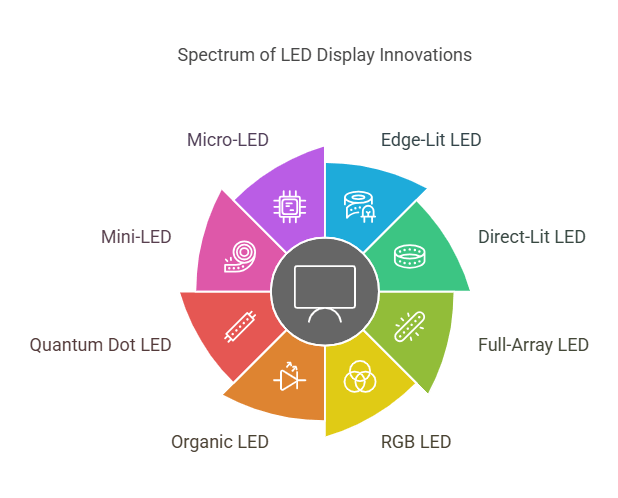
There are various innovative technologies integrated into LED displays, detailed below:
Edge-Lit LED (ELED)
Utilizing edge-lit technology, these LED displays feature lighting fixtures arranged around the screen’s border, focusing light toward the central part. LED strips may be installed at the sides or around the LCD panel. This facilitates a straightforward mechanism where light from the boundaries is channeled through a guide and diffused evenly across the screen, preventing bright spots and delivering a cohesive image display.
Direct-Lit LED
A notch above ELED, the direct-lit LED setup situates the LEDs directly behind the LCD panel rather than around the edges, organized in a grid format to enhance screen illumination consistency. This configuration promises superior brightness and improved uniformity in lighting, albeit at a higher cost than its edge-lit counterpart.
Full-Array LED
Sharing similarities with the direct-lit approach, the full-array variant boasts more LEDs distributed throughout the screen’s rear section, enhancing brightness and color contrast. Its noteworthy local dimming attribute permits individual adjustment of specific screen areas, courtesy of segmented LED zones, to achieve deeper blacks and radiant highlights.
RGB LED
The RGB model operates by manipulating three primary color LEDs—red, green, and blue—to generate a diverse color palette on the display. The intensity variations and combinations of these colors facilitate the representation of many hues, offering a vibrant display experience.
Organic LED (OLED)
OLED technology leverages organic compounds like Triphenylamine or Polyfluorene embedded in a TFT backplane. When energized, these compounds radiate light, creating vibrant images on the screen. Surpassing previous technologies, OLED offers numerous advantages, including a slimmer design due to the absence of backlighting, adjustable pixel brightness, heightened color precision, swift response rates, and unrestricted viewing angles.
Quantum Dot LED (QLED)
The QLED technology represents an advanced iteration of the LCD-LED design, utilizing red-green quantum dots instead of traditional phosphorus filters in other LCD-LED screens. Interestingly, these quantum dots transform the backlight’s blue light into a pristine white light, further filtered through sub-pixels to generate a well-balanced white display hue. This innovation addresses and rectifies the issue of subdued colors in LED displays, offering energy efficiency and improved color contrast.
Mini-LED
An extension of QLED technology, Mini-LED maintains the core principles but incorporates significantly more yet smaller LEDs in the backlighting system. This addition affords finer control over image resolution and contrast, along with the ability to finely adjust the black levels on the display to suit individual preferences.
Micro-LED
Representing a refined version of OLED, micro-LED technology utilizes inorganic substances like Gallium Nitride to emanate light, resulting in vivid display imagery. Despite being pricier than OLED, it offers superior brightness and enhanced display quality, cementing its place as a premium choice in LED technology.
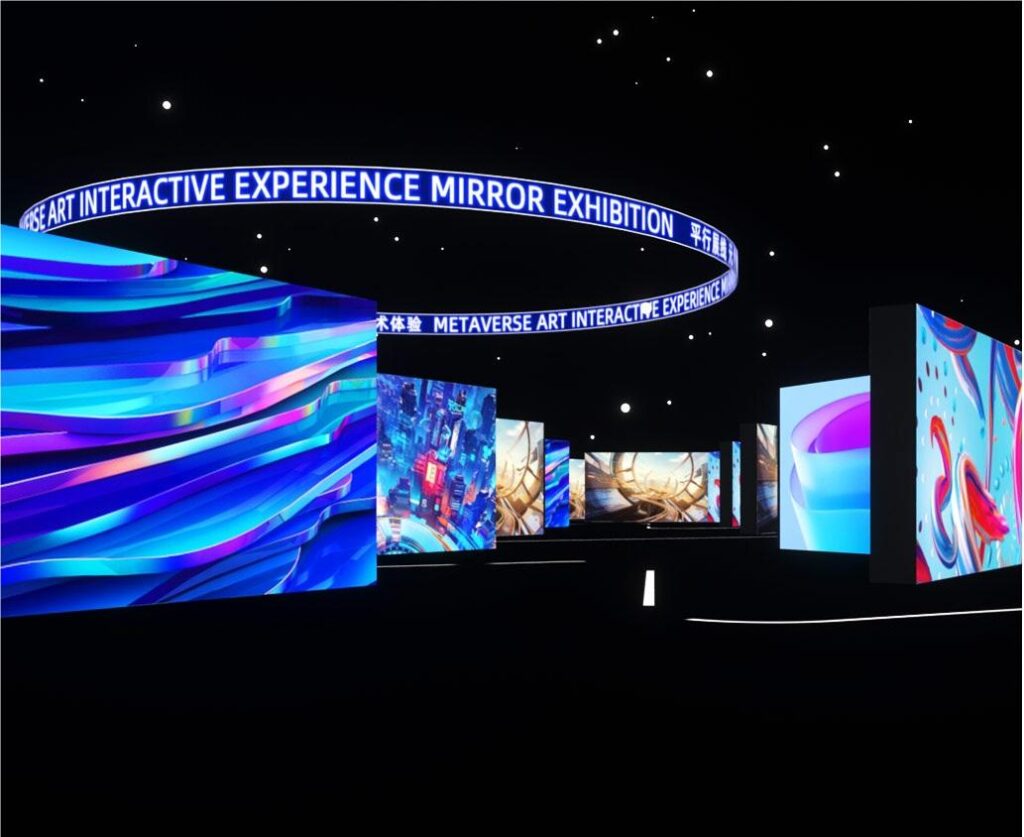
A Comprehensive Guide to LED Display Varieties
Delve into the world of LED displays, which can be categorized based on various features, including the kind of LED packages utilized, their functional attributes, and the shapes of the screens. Here’s a detailed insight into different LED display variants segregated according to these characteristics:
Classification Based on LED Package Types
LED displays vary significantly, primarily based on the package types incorporated in their structure. Traditionally, these displays can be grouped into four distinctive categories, each with its unique features and applications:
1. DIP LED Display
In a DIP (Dual In-line Package) LED display, conventional LED bulbs replace the standard LED chips. Upon close observation, one would notice rows of miniature light bulbs in red, green, and blue hues. These DIP LEDs work in harmony to project vibrant images onto the display.
Key Features:
- Superior brightness compared to other displays
- Retains visibility even under direct sunlight
- It offers a limited viewing angle
- Not the best choice for indoor displays
Applications:
- Outdoor LED displays
- Digital billboards
2. SMD LED Display
Taking center stage in the LED market, SMD (Surface-Mounted Device) LED displays use compact chips instead of the larger bulbs in DIP displays. This technology has been applied to various devices, including TVs and smartphones.
Key Features:
- Elevated pixel density
- High-resolution output
- Extended viewing angle
Applications:
- Indoor LED displays
- Retail advertising platforms
3. GOB LED Display
GOB (Glue-On-Board) LED displays enhance the technology found in SMD displays by adding a protective layer. This additional glue layer shields the screen from adverse weather conditions such as rain and dust while facilitating superior heat dispersion, extending the device’s longevity.
Key Features:
- Enhanced protection against environmental factors
- Low maintenance requirements
- Remarkable durability
- Collision-resistant design
- Facilitates easy transportation
Applications:
- Fine-pitch LED displays
- Transparent LED screens
- Rental LED displays
4. COB LED Display
The COB (Chip-On-Board) LED display represents the forefront of LED technology, offering a superior display quality compared to its SMD counterpart. This design integrates multiple diodes into a single chip, utilizing a solitary circuit for soldering, thus diminishing the chances of LED failure and ensuring seamless operation.
Key Features:
- Exceptional screen brightness
- Elevated pixel density
- Supreme video resolution
- Lower failure rate
- Enhanced energy efficiency
Applications:
- Fine-pitch LED displays
- Mini and Micro LED displays
| Criteria | DIP LED | SMD LED | GOB LED | COB LED |
| Number of diodes | 3 diodes(Red LED, Green LED, & Blue LED) | Three diodes/LED Chip | Three diodes/LED Chip | Nine or more diodes/LED chip |
| Lumens/Watt | 35 – 80 lumens | 50 – 100 lumens | 50 – 100 lumens | 80 – 150 lumens |
| Screen Brightness | Highest | Medium | Medium | High |
| Light Efficiency | Medium | High | High | Highest |
| Viewing Angle | Narrow | Wide | Wide | Wide |
| Heat Dispersion | Medium | High | High | Highest |
| Pixel Pitch | P6 to P20 | P1 to P10 | P1 to P10 | P0.7 to P2.5 |
| Protection Level | High | Medium | Highest | High |
| Price | Medium | Low | Medium | High |
| Recommended Application | Outdoor LED display, Digital billboard | Indoor LED display, Retail advertising | Fine-pitch LED display, Transparent LED display, Rental LED display | Fine-pitch LED display, Mini LED display, Micro LED display |
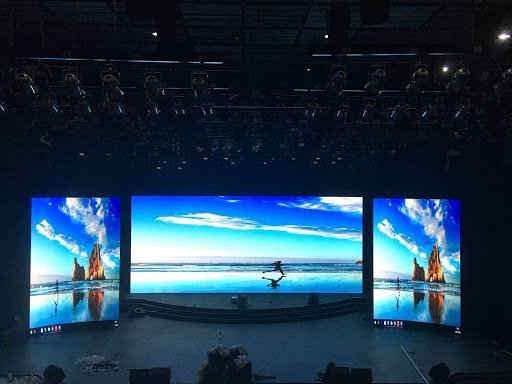
Expounding on the Utility
Delineating the LED displays by their functionality and applications, we can broadly classify them into five distinct categories, delineated as follows:
LED Displays with Textual Representation
Have you ever spotted the “Open/Close” signs illuminating the frontage of eateries? These are classic representations of textual LED displays. These displays specialize in exhibiting alphabets and alphanumeric data, offering fixed text messages without the option for modifications.
LED Displays Facilitating Image Representation
A notch above their textual counterparts, image LED displays facilitate the inclusion of both textual and pictorial content in a stationary format. This technology operates with dual screens to vividly project images. Instances of these displays can be commonly seen as static billboards adorned on streets or highways.
Video-Enabled LED Displays
Video LED displays are crafted to support dynamic image transitions, incorporating a vast array of high-pixel LEDs to render videos with superior resolution. A prime example of this would be the contemporary billboards gracing the skyscraper of Times Square, showcasing high-definition video content.
Digital LED Displays
Digital LED displays closely resemble text LED displays, with their distinctive feature being their exclusive support for numeric representations. These displays find their applications in various settings, such as bank currency boards or digital timepieces, with their functionality hinging on seven-segment nixie tubes that glow in vibrant hues of red or orange to form varied numerical illustrations.
LED Lattice Displays with Image and Text
These displays combine still imagery with moving text, creating a dynamic yet stationary visual experience. Often utilized in scenarios where textual elements are in motion while the image remains stationary, these displays are prominent in airport gates showcasing flight schedules or stadiums projecting live statistics.
Delineations Based on Screen Configurations
LED displays manifest in varied configurations and, based on their physical characteristics, can be classified into three primary groups:
Flat-Configured LED Displays
Also referred to as standard displays, these are the prevalent varieties of LED displays characterized by their sleek surface, which houses a multitude of light-emitting diodes capable of rendering high-resolution visuals. Their ability to generate bright imagery makes them versatile for indoor and outdoor applications.
Curved LED Displays
These displays are flat screens with contoured edges, offering a concave visual platform granting spectators an expansive and enhanced viewing scope. Their appeal lies in their ability to adapt to the peripheral sight of the audience, coupled with a deeper visual depth, offering a more immersive viewing experience than flat-configured displays.
Adaptable LED Screens
Noteworthy for their remarkable adaptability, these screens empower manufacturers to design displays in diverse shapes, thanks to integrating LED chips with PCB or other flexible materials like rubber. Protected by insulation on either side to safeguard the circuits, these screens are easy to operate and facilitate effortless maintenance.
Benefits of Utilizing LED Displays
LED displays come with a plethora of advantages, outlined below:
- Superior Image Quality: LED displays stand out with their varying resolution levels. Enhanced pixel density amplifies the picture quality, ensuring crisp visibility even under the glaring sun.
- Energy Conservation: LED displays are remarkably energy-efficient, utilizing only a fraction of the energy consumed by traditional incandescent bulbs, thus significantly reducing your electricity expenses.
- Remarkable Brightness and Intensity: These displays retain a high brightness level, making them suitable for outdoor setups even under bright sunlight.
- Extensive Color Spectrum: Boasting the ability to portray over 15 million colors, LED displays deliver vibrant and high-contrast visuals unparalleled.
- Durable and Long-lasting: LED displays have an impressive lifespan of approximately 100,000 hours, given they are maintained well and housed in suitable environments.
- Compact and Lightweight: Notably lighter than conventional displays, LED displays occupy less space, facilitating easy installation and transportation based on your requirements.
- Versatility in Design: These displays come in various shapes and sizes, allowing for customization according to your specific needs and preferences.
- User-friendly Programming: Integrated with internet connectivity, LED displays can be controlled remotely, offering convenience in operation and management.
- Wide Viewing Angles: LED displays with enhanced viewing angles offer visibility up to 178 degrees, providing a comprehensive viewing experience from various angles.
- Quick Response Time: With minimal response time, LED displays are ideal for showcasing fast-paced content like sports broadcasts and news.
- Minimal Eye Strain: The flicker-free performance of LED technology reduces eye fatigue, promoting comfortable viewing.
- Hassle-free Installation and Maintenance: These displays are designed to resist water, dust, and corrosion, thus ensuring ease of maintenance and a straightforward installation process.
- Eco-friendly: LED displays are environment-friendly as they do not emit harmful gases and are energy-efficient, requiring lesser maintenance and part production.
- Boosts Brand Image: Implementing LED displays allows for dynamic and attractive visual representation, enhancing brand recall and reputation.
Drawbacks of Utilizing LED Displays
- Light Pollution: The intense brightness of LED displays can cause light pollution, particularly at night. Integrating light sensors can mitigate this issue by adjusting the screen brightness according to the surrounding light conditions.
- High Initial Costs: These displays are costlier than traditional banners or print displays due to the necessary components and operational costs.
- Susceptibility to Damages: LED displays are more vulnerable to defects and damages, necessitating meticulous engineering and maintenance to prevent issues.
- Gradual Color Shift: Over time, LED displays may exhibit color shifting issues, particularly with the representation of the color white, sometimes failing to depict it in its purest form.
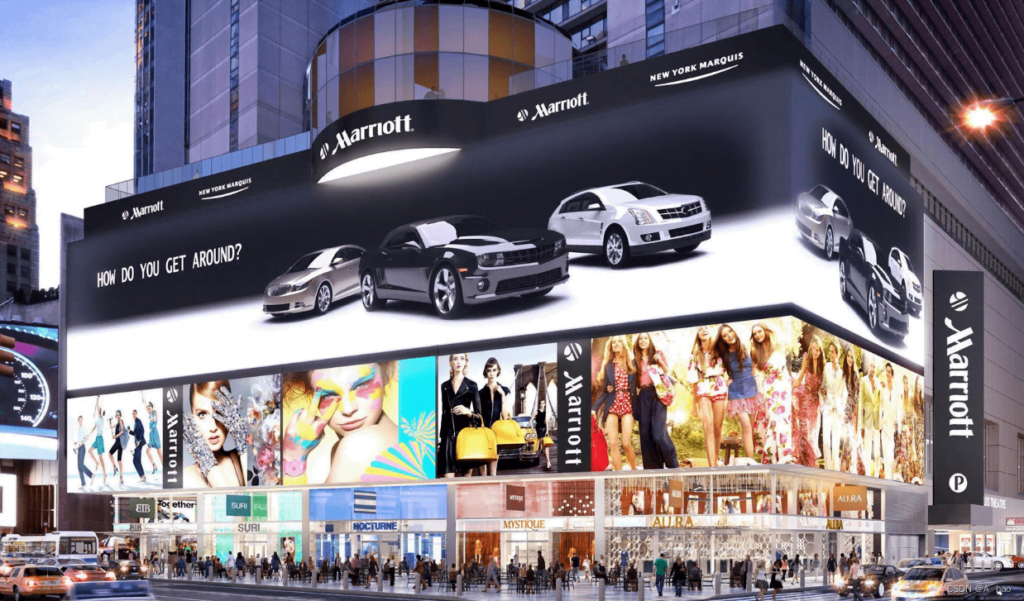
Leveraging LED Display Technology
LED displays find applicability in a myriad of settings, both indoors and outdoors. Here are their prevalent uses and the benefits they bring to each sector:
Conference Rooms
Within the confines of conference rooms, LED displays are revolutionizing how presentations and data analytics are shared, acting as a modern alternative to the customary projectors or whiteboards. Opting for an LED display in such settings ensures:
- Adaptability to any room size, from spacious to compact
- Delivery of high-definition imagery
- Improved screen visibility
- Reduced upkeep compared to conventional displays
- A superior meeting ambiance
Retail Advertising Spaces
Transitioning from traditional signboards and printed banners to LED displays can elevate retail advertising, emphasizing your products through vivid and colorful visuals. This shift not only draws the customer’s eye but presents several additional benefits, including:
- Engaging customer interactions
- Boosting brand prestige
- Cutting down on printing expenses
- Hassle-free installation and maintenance
Digital Billboards
Employing LED displays as digital billboards revolutionizes outdoor advertising. With the brilliance of DIP LED or OLED displays, your advertisement remains prominent even under the blazing sun. Moreover, GOB displays offer robust resistance against adverse weather conditions, making LED displays a prime choice for billboards. These features include:
- Versatile advertisement showcasing through text, eye-catching imagery, and dynamic visualizations
- Lesser maintenance compared to traditional billboards
- Multi-advertisement display capability on a single screen
- Rapid customer attention capture
Sports Venues
At sports arenas or stadiums, LED displays facilitate a vibrant and immersive viewing experience, displaying scores, highlights, and advertisements with superior clarity and brightness. Their incorporation brings forth benefits such as:
- Ensuring spectators at a distance enjoy the match through crystal-clear LED displays
- Offering expansive viewing angles thanks to large display sizes
- Opening avenues for advertising opportunities
- Amplifying audience engagement and adding a thrill to the match
Film and Television Production
LED displays are becoming a staple in TV and film production, providing backdrops that offer audiences a visually enriched experience. Their application in this sector is preferred for reasons like:
- Serving as realistic backdrops, replacing green screens
- Enabling the integration of graphics and information seamlessly during live broadcasts
- Facilitating the display of any computer-generated background, economizing time and studio setup costs
- Offering viewers a captivating and immersive viewing experience
Hotel Ballrooms
Hotel ballrooms constantly buzz with events ranging from business conferences to weddings. Installing LED displays in these spaces can elevate the aesthetic and functional value by showcasing the hotel’s premium interiors, event schedules, and more while reducing reliance on printed backdrops.
Lobby Enhancements
Implementing an LED display in your building’s lobby streamlines the management system and infuses a contemporary vibe into the space. Utilizing an LED display in the building lobby offers several advantages:
- Crafting a lasting impression for visitors from the moment they step in.
- Augmenting the overall value of the building.
- Facilitating seamless dissemination of announcements through the LED display.
Immersive 3D LED Screens: A No-Glasses Experience
Integrating a glasses-free 3D LED screen is an ingenious asset in an era where digital advancements dictate marketing trends. This innovation allows the audience to immerse themselves in a vivid representation of your product, capturing photos and videos freely. Leveraging these visuals as shared content can amplify your brand’s marketing strategy.
Dynamic Visuals in Sales Galleries
Property owners increasingly adopt LED displays in their sales galleries to vividly present product details. This approach not only captivates potential customers but also potentially escalates the return on investment (ROI) by fostering a visually engaging environment.
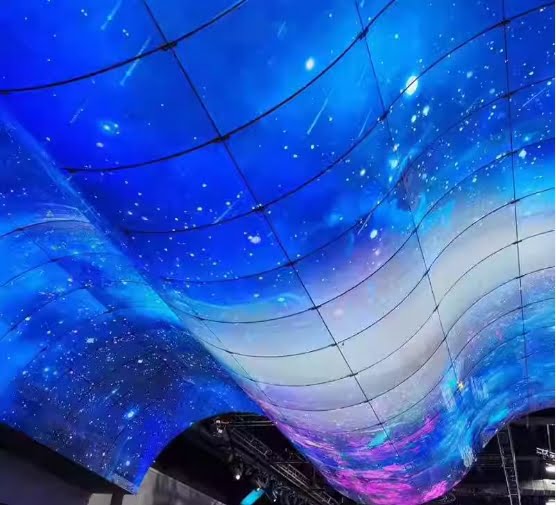
Understanding Key Terms Related to LED Displays
To make an informed decision while choosing an LED display, it’s essential to familiarize yourself with specific key terms that indicate the quality and characteristics of the display. These terms will guide you in identifying your specific needs and selecting the perfect display for your project.
Pixel Pitch:
Pixel pitch is a crucial term that denotes the distance between two adjacent pixels, typically measured in millimeters (mm). A lower pixel pitch indicates a smaller distance between the pixels, resulting in a higher pixel density and, consequently, superior image quality. This term is often represented by the letter ‘P.’ For instance, a P4 LED display would signify that the pixel pitch is 4 mm. To assist you further, here is a chart illustrating various pixel pitch values and their implications:
| Naming Of LED Display (Based on pixel pitch) | Pixel Pitch |
| P1 LED Display | 1mm |
| P2 LED Display | 2mm |
| P3 LED Display | 3mm |
| P4 LED Display | 4mm |
| P5 LED Display | 5mm |
| P10 LED Display | 10mm |
| P40 LED Display | 40mm |
Resolution:
Resolution is another significant term that denotes the total number of pixels presented on the LED screen, directly indicating the potential picture quality. The concept can be illustrated by comparing a large screen with low resolution and a smaller one with high resolution; despite its size, the latter would deliver a superior image owing to its higher resolution. A higher resolution equates to an increased number of pixels and improved image clarity.
The resolution of an LED display is indicated by two values representing the number of pixels aligned vertically and horizontally. For example, an LED display boasting an HD resolution will feature 1280 vertical pixels and 720 horizontal pixels. The naming of LED displays often varies based on their respective resolutions, as demonstrated in the following chart to help you grasp the concept better:
| Resolution | Pixel Number (Vertical x Horizontal) |
| HD | 1280 x 720 |
| Full HD | 1920 x 1080 |
| 2K QHD | 2560 x 1440 |
| 4K UHD | 3840 x 2160 |
| 5K | 5120 x 2160 |
| 8K | 7680 x 4320 |
| 10K | 10240 x 4320 |
Optimal Viewing Distance
The viewing distance refers to the extent to which the LED display retains optimal picture quality. This distance is integral in ensuring the viewer gets the best visual experience. Notably, the pixel pitch plays a vital role in determining this distance. A smaller pixel pitch corresponds to a shorter minimum viewing distance, making displays with smaller pixel pitches more suitable for smaller rooms.
Calculating the optimum viewing distance involves multiplying the minimum viewing distance by three. To illustrate, if an LED display features a pixel pitch of 2 mm, the minimum viewing distance is 2 meters; hence, the optimal distance would be 6 meters (2 meters x 3).
| LED Display | Pixel Pitch | Minimum Viewing Distance | Optimum Viewing Distance |
| P1.53 Fine Pitch Indoor LED Display | 1.53 mm | >1.53 m | >4.6 m |
| P1.86 Fine Pitch Indoor LED Display | 1.86 mm | >1.86 m | >5.6 m |
| P2 Indoor LED Display | 2 mm | >2 m | 6 m |
| P3 Indoor LED Display | 3 mm | >3 m | 9 m |
| P4 Indoor LED Display | 4 mm | >4 m | 12 m |
| P5 Indoor LED Display | 5 mm | >5 m | 15 m |
| P6.67 Outdoor LED Display | 6.67 mm | >6.67 m | >20 m |
| P8 Outdoor LED Display | 8 mm | >8 m | >24 m |
| P10 Outdoor LED Display | 10 mm | >10 m | >30 m |
Viewing Angle and Its Importance
The viewing angle is another critical factor, indicating the maximum angle at which viewers can enjoy consistent picture quality. This element is especially crucial when considering the viewer’s positioning on the screen. For instance, viewing angles become less relevant if a person is positioned centrally on the screen. Still, it plays a significant role for viewers in an off-center position. A limited viewing angle might result in a diminished, darker display. Therefore, larger viewing angles are preferred for outdoor billboards and retail malls, allowing for a high-quality viewing experience from various directions. Generally, a viewing angle between 120 and 160 degrees offers satisfactory display quality, with 178 x 178 degrees representing the broadest viewing angle.
Refresh Rate and Its Impact
The refresh rate of an LED display, measured in Hertz (Hz), signifies the frequency at which an image on the screen is updated every second. A higher refresh rate is advisable for optimal public engagement as it avoids visual disruptions, such as black lines appearing in photos or videos captured from the screen. Attaining a higher refresh rate can be achieved through the following measures:
- We are investing in a high refresh rate LED display module.
- I am opting for a high-end driving IC.
- You are utilizing an adept LED control program to manage your LED display.
Brightness: Striking the Right Balance
Brightness in LED displays is quantified in nits, with a more excellent nit value denoting a brighter screen. However, brighter isn’t always better. It’s imperative to assess the specific needs of your application when selecting brightness levels. A brightness range between 300 and 2500 nits for indoor settings is generally acceptable to avoid eye strain or headaches. Contrastingly, venues like stadiums require higher brightness levels. Below is a guideline chart to help you choose the appropriate brightness levels for varied applications:
| Application | Recommended Display Brightness |
| Indoor | 300 to 2,500 nits |
| Semi-Outdoor | 2,500 to 5,000 nits |
| Outdoor | 5,000 to 8,000 nits |
| Outdoors with direct sun exposure | Above 8,000 nits |
Understanding Contrast Ratio in LED Displays
The contrast ratio is a vital metric in LED displays, quantifying the discrepancy in brightness between the deepest black and the purest white. This figure is a marker for the display’s ability to deliver vivid and rich color quality. A superior contrast ratio equates to enhanced picture clarity. For instance, an LED display boasting a 1000:1 contrast ratio signifies that the darkest black displayed is 1000 times less bright than the brightest white. Unfortunately, a lower contrast ratio can degrade the visual experience, rendering images somewhat grayish and lackluster. Therefore, opting for LED displays with a more substantial contrast ratio is a priority for achieving optimal visual output.
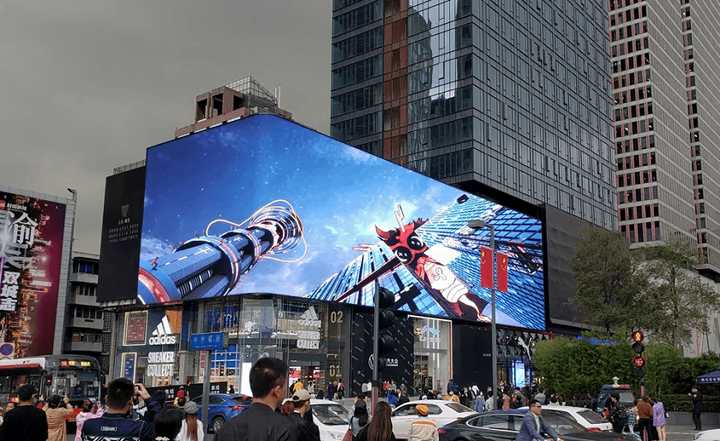
Selecting the Ideal LED Display: A Purchaser’s Handbook
Having acquainted yourself with the foundational aspects and terminology about LED displays in the preceding segment, let us navigate the process of selecting the best LED display for your needs.
To facilitate a quick decision, refer to the list of China’s Top 10 LED Display Manufacturers.
Assessing the Installation Locale – Indoor vs. Outdoor
One critical factor when choosing your LED display is the intended installation location, which influences the necessary brightness level. In indoor settings, a display with a lower brightness level suffices, though it’s advisable to account for the available lighting in the room. Conversely, opt for displays with greater brightness levels for outdoor installations, particularly if the display is exposed to direct sunlight.
Identifying Screen Size Needs
The selection of the appropriate screen size for your LED display hinges on various factors such as room dimensions, resolution, and pixel pitch. Screen size is defined as the display’s width multiplied by its height. However, note that the optimal size can vary based on resolution differences. Here is a basic guideline to assist you in determining the suitable screen size for an LED display:
To determine the appropriate screen size for an LED display, you can use the following formula:
Optimal Screen Dimensions (m)=(Resolution×Pixel Pitch)÷1000
Take a look at the following instances, assuming the pixel pitch is 3mm:
- HD Resolution (1280 x 720):
- Screen Width: (1280×3)÷1000=3.84 m
- Screen Height: (720×3)÷1000=2.16 m
- Suggested Screen Dimensions: 3.84 m (W)×2.16 m (H)
- Full HD Resolution (1920 x 1080):
- Screen Width: (1920×3)÷1000=5.76 m
- Screen Height: (1080×3)÷1000=3.24 m
- Suggested Screen Dimensions: 5.76 m (W)×3.24 m (H)
- UHD Resolution (3840 x 2160):
- Screen Width: (3840×3)÷1000=11.52 m
- Screen Height: (2160×3)÷1000=6.48 m
- Suggested Screen Dimensions: 11.52 m (W)×6.48 m (H)
As illustrated above, the screen size will fluctuate depending on the pixel pitch and resolution. It is also influenced by changing the pixel pitch while maintaining the exact resolution. Therefore, while choosing an LED screen, it is essential to consider the pixel pitch and resolution and the size of the room where the screen will be installed.
Understanding IP Ratings
The IP rating is a significant parameter that denotes the protective measures of an LED display against foreign objects and moisture ingress. It consists of two numerical indicators – the first digit signifies protection against solid particles like dust, while the second denotes resistance to liquids.
Though a higher IP rating offers enhanced protection against dust, rain, and collisions, it is not always necessary. The ideal IP rating depends on the application of the LED display. Investing in a higher IP rating might be financially imprudent for indoor installations. However, higher protection levels are necessary for outdoor applications such as billboards, necessitating at least an IP54 or IP65 rating to shield the display from dust, heavy rains, and solid objects.
Evaluating Features & Performance
When in the market for an LED display, you’ll encounter a variety of terms used to delineate quality aspects. Before delving deep, it’s essential to identify your specific needs and align them with the attributes of the products you’re considering. To aid in your selection for a high-quality display, consider these brief pointers:
- Opt for an LED display boasting a superior resolution to enhance visual clarity.
- Seek a higher contrast ratio for vivid hues and a richer image quality.
- Prioritize higher refresh rates to minimize screen flicker issues and ensure fluid motion.
- Select an appropriate viewing angle based on your specific use case. A narrower viewing angle suffices when the audience is positioned centrally, like in a meeting room setup. Conversely, a wider viewing angle is preferable for setups targeting a dynamic audience, such as displays in retail malls.
Power Efficiency Analysis
The power efficiency of LED displays is influenced by a spectrum of factors, including the underlying technology, luminosity, and panel dimensions. Moreover, the setup’s application has a significant bearing on energy utilization. For example, even at identical brightness levels, an exterior LED display draws more power than an indoor counterpart. Consult the graph below to gain deeper insights into the patterns of energy consumption:
| Display Type | Energy Consumption (W/m) | Max Brightness Level (nits) |
| P4 Indoor LED Display | 290 | 1800 |
| P6 Indoor LED Display | 290 | 1800 |
| P6 Outdoor LED Display | 375 | 7000 |
| P8 Outdoor LED Display | 400 | 7000 |
| P10 Outdoor LED Display | 450 | 7000 |
| P10 Energy Saving Outdoor LED Display | 200 | 7000 |
From the chart presented above, it’s evident that outdoor LED displays consume more electricity. Additionally, as the pixel pitch escalates, so does the energy consumption. This tends to align with the augmented resolution demanding higher power input. Nevertheless, opting for energy-efficient alternatives can substantially reduce your electricity bills.
Review the Warranty Terms
Most LED display manufacturers extend a warranty spanning 3 to 5 years. Although under regular maintenance, LED displays have the durability to function efficiently for over seven years. It’s prudent, however, to scrutinize the warranty terms and the services offered before making a purchase.
LED Display Installation Techniques
Depending on their application, LED displays can be installed in various ways. Installing outdoor LED displays, for instance, is more intricate than indoor installations, requiring sturdier structures to endure harsh weather elements like winds and storms. In contrast, indoor installations don’t necessitate such considerations. Below, explore the diverse installation techniques for indoor and outdoor LED displays and select the one that best aligns with your project requirements.
Wall Mounted Installation
Suitable for indoor and outdoor settings, wall-mounted installations involve affixing brackets to the wall for indoor setups, with the strength of the brackets being a vital consideration due to the weight of the LED display. On the other hand, outdoor setups, such as digital billboards, necessitate a custom steel frame attached to the building wall, featuring a maintenance platform sandwiched between the wall and the display. Indoor setups commonly employ a front maintenance system.
Wall Embedded Installation
Opting for a wall-embedded installation grants your LED display a sleek appearance. This method entails mounting the display within the wall, complemented by a front maintenance system, and is apt for indoor and outdoor setups. However, the installation process can be complex, requiring precise calculations for embedding the screen at the correct depth.
Ceiling Hung Installation
Ceiling-hung installations are frequently seen in railway stations and event arenas, which are ideal for indoor venues experiencing high foot traffic. This method demands careful consideration of the ceiling’s strength to safely support the hefty weight of the LED displays, preventing potential accidents.
Pole Installation
Pole installations are predominantly utilized for LED billboards, although this is a pricier option due to the necessity of constructing a concrete foundation for the poles. This procedure encompasses soil strength and wind load assessments, with the pole height being crucial to avoiding interfering with nearby structures. The elevated installation ensures optimal visibility, allowing the content to be viewed from a distance. Pole installations are categorized into:
- Single-pole installation for compact LED displays.
- Double-pole installation for larger displays, offering enhanced support.
Roof Installation
Implementing roof installations can magnify content visibility, commonly found in metropolitan areas with towering structures. Despite the challenges of wind loads, roof installations are less expensive than pole setups, eliminating the need for a concrete foundation. Assessing the building’s structure and capacity to bear the screen’s weight is vital.
Mobile LED Display
Emerging as a contemporary advertising medium, mobile LED displays involve mounting screens on vehicles. As the vehicle moves, it broadens the reach of the displayed content, garnering increasing popularity each day.
Elements Influencing the Longevity of LED Displays
LED displays are renowned for their resilience and prolonged lifespan. However, certain aspects can significantly influence their longevity, which are detailed below:
1. Environmental Temperature & Effective Heat Management
The environmental temperature plays a critical role in determining the longevity of LED displays. Elevated ambient temperatures can escalate the operational temperature of the displays, leading to potential overheating and subsequently diminishing the lifespan of the internal components. Implementing a proficient heat management strategy is vital to prevent this. Solutions could include installing fans or air conditioning systems to curb overheating, with surface radiation treatment also a viable option for temperature regulation.
2. Adequate Power Supply Configuration
Power requirements for LED displays vary between indoor and outdoor setups. It’s imperative to have a finely calibrated display setup and proper installation to facilitate an optimal power supply. This measure ensures maximum power efficiency without compromising the display’s lifespan.
Comparing LED and LCD Display Technologies
LCD technology served as a precursor to the development of LED displays. Although it has several downsides, it continues to be a formidable contender in the market, mainly owing to its affordable pricing structure. Here, we delineate the distinguishing characteristics between the two:
- LED displays utilize light-emitting diodes for image creation, while LCDs employ liquid crystals to generate light.
- LEDs can generate light autonomously, negating the need for external lighting sources, a necessity that raises questions about the picture quality of LCDs.
- When considering outdoor installations, LED displays have a clear advantage with their ability to offer considerably higher brightness levels than LCDs, making them the preferred choice for outdoor setups.
- LED displays boast a superior contrast ratio to LCDs, offering viewers a spectrum of vibrant colors, enhanced highlights, and precise color accuracy.
- LCDs fall short in high-traffic areas due to their restricted viewing angles. In contrast, LED displays excel with wide viewing angles, reaching up to 178 degrees both vertically and horizontally, ensuring content enjoyment from various perspectives.
- LED technology is a frontrunner in energy efficiency among other lighting systems, making LED displays more environmentally friendly and cost-effective than LCDs.
- LED displays offer a seamless viewing experience courtesy of their thinner module bezels, a feature that contrasts starkly with the disruptive, narrow, visible bezels found in LCDs.
- Regarding durability, LED displays outshine LCDs, with lifespans extending over 100,000 hours, though inadequate maintenance can potentially disrupt this longevity.
| Criteria | LED Display | LCD Display |
| Lighting Technology | Light Emitting Diodes | Liquid Crystal with backlighting |
| Contrast Ratio | High | Medium |
| Viewing angle | Wide | Narrow |
| Power consumption | Low | Medium |
| Screen Brightness | High | Medium |
| Color Accuracy | High | Medium |
| Bezel | Bezel-less | Thin visible bezels |
| Lifespan | Long | Medium |
| Cost | High | Medium |
LED and OLED Displays: A Comparative Analysis
OLED, representing the next evolution in LED display technologies, offers several notable improvements over traditional LED solutions. The primary distinction between them lies in their construction and operation. In an OLED display, organic compounds light up upon receiving electrical currents, a feature absent in LED displays which necessitates backlighting.
Regarding delivering performance, OLED pulls ahead with more accurate color representation and a broader viewing scope than LED displays. Moreover, OLED displays allow for the modulation of brightness at the level of individual pixels, facilitating an unparalleled contrast ratio. This technological advancement places OLED displays a notch above LED displays, although this comes at a higher price point.
Indoor Versus Outdoor LED Displays: What Sets Them Apart?
Differences between indoor and outdoor LED displays abound, making the selection process dependent on various factors. The key distinguishing attributes between them encompass:
| Criteria | Indoor LED Display | Outdoor LED Display |
| Definition | The LED displays installed in indoor areas are called indoor LED displays. | Outdoor LED displays refer to the displays installed in outdoor areas. |
| Size | This type of LED display is usually small and medium in size. | They are primarily bulky in size. |
| Brightness | Indoor LED displays have a higher brightness level higher than outdoor ones. | As outdoor LED displays face direct sun exposure, they have higher brightness levels. |
| IP Rating | IP20 or above is enough for an indoor LED display. | They need a higher IP rating of IP65 or at least IP54 to withstand rain, wind, dust, and collision. |
| Waterproofing | Indoor LED displays don’t require waterproofing as they don’t face adverse weather conditions. | As outdoor LED displays face rain and storms, they require waterproofing. |
| Ease Of Installation | Installation of indoor LED displays is straightforward. | Outdoor LED displays are difficult to install. |
| Maintenance Level | They are easy to maintain. | This type of LED display is hard to maintain. |
| Power consumption | Indoor LED displays consume less power than outdoor displays. | As outdoor displays are more extensive and produce brighter images, they consume more power. |
| Viewing Distance | The indoor display has less viewing distance. | The viewing distance of outdoor LEDs is more to ensure maximum visibility. |
| Price | The price of these LED displays is lower than outdoors. | As outdoor LED displays require better protection, higher image quality, and robust installation, they are much more expensive. |
| Application | Bank countermeeting room Hall Ballroom Building lobby supermarket promotion display boards | Billboard Stadium scoreboard Retail advertisement |
Emerging Innovations and Developments in LED Displays
LED displays have already revolutionized the advertising industry. Yet, with continuous advancements in technology, we witness the emergence of newer and more advanced trends in LED displays. Here are some notable developments:
Enhanced High Dynamic Range (HDR) Displays
HDR, which stands for High Dynamic Range, propels the digital display experience to unprecedented heights. Future enhancements in HDR technology are slated to bring forth:
- Ultra-high resolutions, extending to 8K and beyond
- The superior contrast and authentic HDR depiction
- Expanded color palettes
- Elevated brightness levels coupled with enriched contrast
- Intelligent brightness adaptation
Adaptive Curved and Flexible Displays
While not entirely new, the prevalence of curved and flexible displays is escalating within the LED display sector. These displays offer unique advantages that transcend the capabilities of traditional flat displays.
Curved and flexible LED displays extend beyond the functionalities of flat screens, offering viewers an immersive visual experience. While curved screens enhance viewer engagement, flexible displays cater to installations in intricate spaces with irregular contours, like curving walls or unusually structured areas. As these technologies progress, we expect to witness a surge in innovative designs incorporating these adaptable displays.
Transparent & Translucent LED Displays
Marking a significant shift in display technology, transparent and translucent LED displays offer a glimpse into the future. These displays facilitate a semi-see-through viewing experience, adding a futuristic and sophisticated touch to any space. This technology is poised to become a mainstay in retail, architectural showcases, and digital signage. To delve deeper, refer to our article: “Understanding Transparent LED Screens and Their Functionality.”
Augmented Resolution and Pixel Density
With each passing day, the resolution and pixel density of LED displays are experiencing an uptick, catering to the escalating demand in applications such as digital signage and billboards. Enhanced resolution ensures pristine image quality, providing vivid and detailed visual presentations. As pixel density amplifies, we can predict a significant enhancement in the resolution of LED displays shortly.
Harnessing the Power of AI and IOT in LED Displays
LED displays are evolving, blending seamlessly with advancements in Artificial Intelligence (AI) and the Internet of Things (IoT), ushering in a new wave of innovation. These modern displays offer an enriched and natural interaction with virtual environments, surpassing their traditional counterparts. You can anticipate a plethora of intelligent functionalities incorporated into LED displays, such as:
- Voice-activated controls
- Gesture-based commands
- Automated content tailoring according to viewer preferences
- Synchronized data amalgamation for vibrant content presentation
Navigating Common LED Display Challenges
Like any sophisticated gadget, LED displays aren’t immune to occasional malfunctions. To address these efficiently, it’s vital to acquaint yourself with the usual challenges and troubleshooting methods. Below, find a guide outlining the prevalent issues and the steps to remedy them:
Module Color Anomalies
Sometimes, a module might appear colorless, a problem often arising from a loose or damaged cable. To resolve this, attempt reconnecting the cable multiple times. If unsuccessful, a cable replacement might be in order. For outdoor LED displays experiencing this issue, seeking professional assistance promptly is advised to prevent further complications.
Receiving Card Malfunction
A crucial component in the display setup, the receiving card, orchestrates data transfer from the controller to various panels, facilitating the formation of a cohesive image. When malfunctioning, it disrupts the accurate portrayal of images. Addressing this involves repairing or substituting the defective receiving card with a new one.
Power Supply Disruptions
When specific sections or the entire screen turns dark, thoroughly examining the power supply is necessary. Ensure a flawless circuit setup and connection stability. If the problem persists, it’s wise to consult a technician specializing in this field.
Module Discrepancies
Occasionally, the module might not display the appropriate brightness levels. Under such circumstances, inspect the connection lines between the functioning and non-functioning modules. Remedying a defective cable often resolves the brightness inconsistency.
Controller Dysfunction
The heart of LED displays, the controller, is responsible for data transmission to create vibrant images. A malfunctioning controller hampers this data flow, resulting in display issues. This could stem from cable defects or controller failures. A comprehensive check of all connections followed by a system restart might rectify the issue. If unsuccessful, reaching out to a qualified technician is recommended.
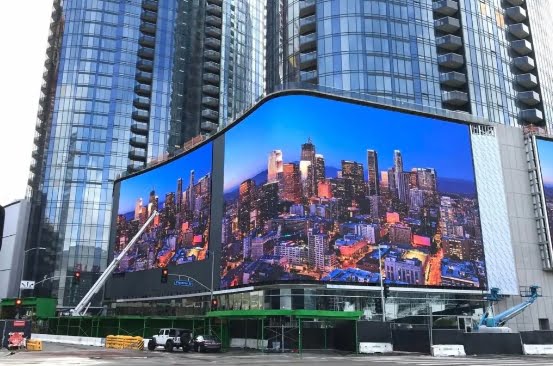
The Final Verdict
LED displays stand as a powerhouse in advertising and visual showcases. Elevate your brand’s prominence by incorporating these vibrant displays, promising your audience a visually spectacular experience.
These dynamic LED displays harness varying technologies tailored to indoor or outdoor settings. Selecting the perfect unit demands consideration of several factors, including pixel pitch, resolution, viewing angle, and contrast ratio. Furthermore, it is vital to consider the extent of sunlight exposure, optimizing the brightness level accordingly to ensure a seamless viewing experience. For instance, indoor settings necessitate less intense brightness than their outdoor counterparts, with semi-outdoor displays finding a balance in between, shielding viewers from the glare of direct sunlight.
In the evolving landscape of technology, LED displays are carving out a burgeoning space to fuel innovative approaches in the advertising sector. Brace yourself to explore the revolutionary trajectory of LED displays as they redefine the future of visual engagement.
FAQs
LED displays work by using light-emitting diodes (LEDs) to create images, text, or videos. These diodes emit light when electricity passes through them, creating bright and vibrant visuals. RGB LEDs are commonly used to produce full-color displays by combining red, green, and blue light.
When choosing an LED display, consider factors like resolution, brightness, size, viewing angle, and environmental durability. Higher resolution provides clearer images, while brighter displays are essential for outdoor settings. Consider the pixel pitch (distance between pixels) for optimal clarity.
Pixel pitch refers to the distance between individual pixels in an LED display. A smaller pixel pitch means higher resolution, as the pixels are packed closer together, resulting in sharper and more detailed images. Indoor displays typically have a smaller pixel pitch than outdoor displays, which may have a larger pitch for long-distance viewing.
Yes, LED displays are perfect for outdoor advertising due to their high brightness, weather resistance, and visibility in direct sunlight. When choosing an outdoor LED display, ensure it has a high IP rating for protection against water, dust, and other environmental factors.
LED displays are highly energy-efficient compared to traditional display technologies. They consume less power and last longer, which makes them a cost-effective option for long-term use. LED technology is known for low power consumption, helping to reduce electricity bills while maintaining high brightness and quality.
To maintain an LED display, regularly clean the surface with a dry cloth to remove dust and dirt. Check for damaged pixels and replace any malfunctioning parts. For outdoor displays, ensure that they are properly sealed to protect against weather conditions. Regular maintenance will help ensure long-lasting performance.

Hi, I’m Xylia Xiong, a sales professional with 14 years of experience in the LED strip light industry. I specialize in providing tailored solutions, leveraging my expertise in LED products and the latest industry trends. Known for effective communication and problem-solving, I’m dedicated to helping lighting manufacturers, importers, and distributors achieve their goals.
Let’s work together to create customized solutions that exceed expectations.
Related Posts

The Best LED Strip Lights You Can Buy Right Now

Comparing WS2811 Vs WS2812B: Key Differences


